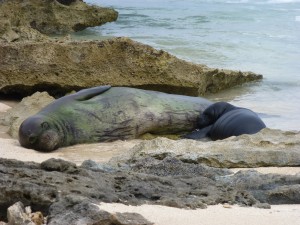Our adventures today take us to the northern end of Oahu to check up on a special new mother, the monk seal R5AY or ‘Honey Girl’ and her 22-day-old calf. Honey Girl is one of 1100 endangered monk seals currently inhabiting the Hawaiian Archipelago. NOAA researcher Tracy Wurth, who specializes in Hawaiian Monk Seals, has joined our class, graciously giving us her time and expertise. During our trek to Honey girl’s haul-out beach, we discuss the challenges of managing monk seals, which often necessitates managing people more than seals.

Honey Girl Hauled out on the beach
The 200 or so monk seals living on the Main Hawaiian Island must contend with potentially harmful interactions with humans. These monk seals usually haul-out, or come ashore on beaches to rest, individually and often near large concentrations of people. Attitudes towards the seals are mixed. Some Native Hawaiians see the seals as yet another way the federal government seeks to impose outsider control on the islands and other non-native Hawaiians simply do not respect the conservation goals. Incidents range from idiotic attempts to hug seals to violent aggression against the seals. On the other end of the spectrum are sometimes overzealous volunteers who coordinate monitoring of seals and even assist in rescue efforts.


Warning signs to protect monk seals
Tracy clearly spends a lot of time thinking out about and dealing with these volunteers. On our drive, she explains the current balancing act of managing the volunteers. While they enable the large-scale conservation efforts utilized in conserving the seals, they often have a hard time separating conservation goals from personal attachments to the seals. Volunteers have even become embroiled in physical confrontations over defending the seals. These passions are in part a result of the management approach utilized by NOAA, which is surprisingly hands-on and direct. Usually, conservation efforts are more removed and focused at the population level. Here on Hawaii, however, monk seals receive direct interventions such as de-worming and even surgery. These efforts have had a measurable impact at the population level, with an estimated 17-24% of the population owing its existence to these efforts, according to work by Harting and other researchers. But, the direct actions can leave volunteers feeling responsible for individual seals and make it hard to consider the population as a whole. Instead, a volunteer may develop a strong attachment to “their seal”.

Cookies distributed by the volunteer network to raise awareness about monk seals

Honey Girl and her pup
When we arrive at the beach it’s easy to see why the volunteers feel so passionately about these seals. A rescued seal herself, Honey Girl could be a poster seal for NOAA’s efforts to save the Monk Seal. She seems very vulnerable sleeping on the beach with her new pup and with her dog-like eyes she is charismatic. One volunteer has set up an observation station near the protective border surrounding the mom and pup, and carefully notes both the seals’ behavior and the visitors strolling by for a peak. Later, another volunteer arrives and urges us to take our pictures and leave quickly, lest we disturb the seal, until she realizes Tracy has escorted us to the site.

Honey girl and pup
We spend some quality time on the beach watching Honey Girl and her pup and then head out to find some tacos in Haleiwa before setting off in the car back to Honolulu. Reflecting on the day, it’s one thing to learn about managing an endangered species in a classroom. A benefit to this course is experiencing the complexities of actually implementing management. Today has revealed that planners must also account for people’s reactions when developing conservation strategies for species.


Honey Girl (left) and pup (right)
